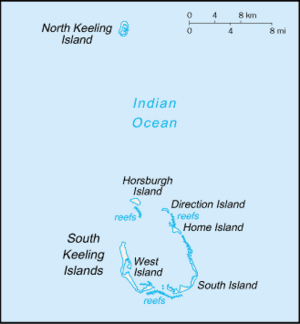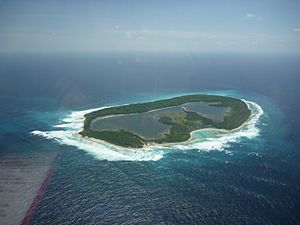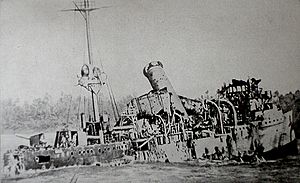North Keeling facts for kids
Quick facts for kids
Designations
|
|
| Official name: Pulu Keeling National Park | |
| Designated: | 17 March 1996 |
|---|---|
| Reference #: | 797 |
North Keeling is a small island shaped like a ring, made of coral. It's part of the Cocos (Keeling) Islands, which belong to Australia. This island is about 25 kilometers (15.5 miles) north of Horsburgh Island and covers an area of about 1.2 square kilometers (0.46 square miles).
North Keeling is special because it's home to the only remaining group of the very rare Cocos buff-banded rail, a type of bird. Many other seabirds also come here to build their nests and raise their young. Since 1995, North Keeling Island and the ocean around it (up to 1.5 kilometers or about 1 mile from shore) have been protected as the Pulu Keeling National Park.
Contents
Discovering North Keeling's History
People believe that Europeans first saw the Cocos (Keeling) Islands in 1609. This happened when Captain William Keeling was sailing for the East India Company. The islands were named after him. North Keeling was drawn on maps as early as 1749 by a Swedish captain named Ekeberg, who showed coconut trees growing there. It also appeared on a British map in 1789.
In 1836, Captain Robert FitzRoy and the famous scientist Charles Darwin visited North Keeling on their ship, the HMS Beagle. Like many others, they found it hard to land on the island.
During the 1800s, some people who were sick with a disease called Beriberi were brought to the island. You can still find graves there from these people, as well as from sailors whose ships were wrecked nearby.
The Battle of Cocos
On November 9, 1914, during World War I, a German warship called the SMS Emden attacked a radio station on Direction Island. This caught the attention of an Australian warship, the HMAS Sydney. After a battle that lasted about 90 minutes, the Emden was badly damaged. Its crew had to steer it onto the shore of North Keeling Island to keep it from sinking.
Later, in 1915, a Japanese company thought they could fix the Emden and make it float again. But after an inspection, it was clear that waves had damaged the ship too much. By 1919, reports said that the wreck had almost completely broken apart and disappeared into the sea.
Seabird Hunting on the Island
Between the First and Second World Wars, groups of about 20 Cocos Malays would stay on North Keeling Island for up to two weeks at a time. They would gather wood, coconuts, and birds to take back to Home Island. In the 1970s and 1980s, people started using faster boats and firearms. This led to more seabirds being hunted, which worried people who cared about the bird colonies.
Pulu Keeling National Park
In 1986, an agreement was made to limit and carefully manage any future hunting on North Keeling. This was between the Australian National Parks and Wildlife Service and the Cocos Malay people. In 1989, a big storm called Cyclone John badly damaged the red-footed booby bird colony on North Keeling. Because of this, legal hunting stopped so the birds could recover. No legal hunting has happened since then.
The Pulu Keeling National Park was officially created on December 12, 1995. It's very important as a place for seabirds and marine turtles to breed. It's also the home of the unique Cocos buff-banded rail and the Cocos angelfish.
This national park was created to:
- Keep the area in its natural state.
- Encourage people to use, enjoy, and appreciate the area in a proper way.
You need special permission to visit the park.
Other Protected Areas
North Keeling Island is also recognized as a very important wetland under an international agreement called the Ramsar Convention. It was listed on March 17, 1996.
The island is also known as an Important Bird Area by BirdLife International. This is because it has more than 1% of the world's population of red-footed boobies, lesser frigatebirds, and common noddies. It might even have the largest red-footed booby colony in the world! It also has the second-largest group of lesser frigatebirds in Australian territory.
See also
 In Spanish: Keeling del Norte para niños
In Spanish: Keeling del Norte para niños




